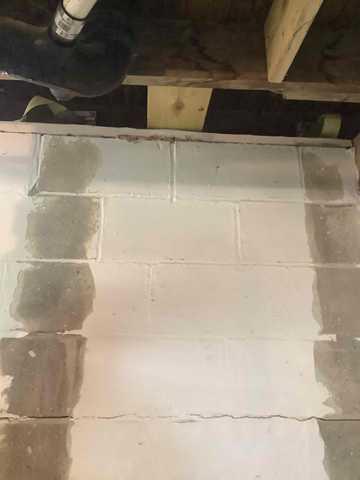
Stabilization and Waterproofing
In order to correct this bowing foundation wall, we installed six Fortress Carbon Fiber Straps on the south wall of the basement. We ground the wall surface to prepare for the initial epoxy layer. We then used hydraulic cement to patch a small area at the bottom that had sheared and attached neck ties to the rim joist and bridged all six straps. Around the perimeter of the basement, approximately 12 inches of concrete was broken away from the wall to install the WaterGuard system. Every hollow block core was drilled to add weep holes. Filter cloth and bed of stone was also installed for additional drainage. The floor was put back together and the system was tied into the existing sump pump.
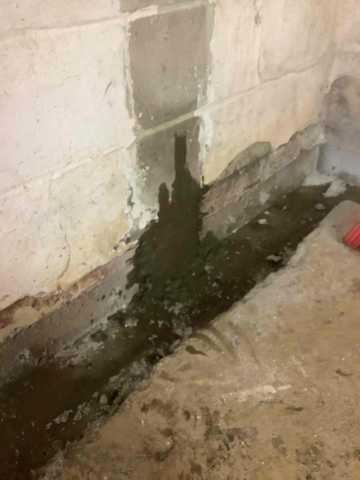
Stabilization and Waterproofing
In order to correct this bowing foundation wall, we installed six Fortress Carbon Fiber Straps on the south wall of the basement. We ground the wall surface to prepare for the initial epoxy layer. We then used hydraulic cement to patch a small area at the bottom that had sheared and attached neck ties to the rim joist and bridged all six straps. Around the perimeter of the basement, approximately 12 inches of concrete was broken away from the wall to install the WaterGuard system. Every hollow block core was drilled to add weep holes. Filter cloth and bed of stone was also installed for additional drainage. The floor was put back together and the system was tied into the existing sump pump.
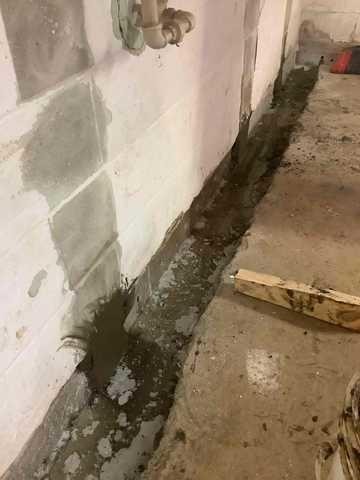
Stabilization and Waterproofing
In order to correct this bowing foundation wall, we installed six Fortress Carbon Fiber Straps on the south wall of the basement. We ground the wall surface to prepare for the initial epoxy layer. We then used hydraulic cement to patch a small area at the bottom that had sheared and attached neck ties to the rim joist and bridged all six straps. Around the perimeter of the basement, approximately 12 inches of concrete was broken away from the wall to install the WaterGuard system. Every hollow block core was drilled to add weep holes. Filter cloth and bed of stone was also installed for additional drainage. The floor was put back together and the system was tied into the existing sump pump.
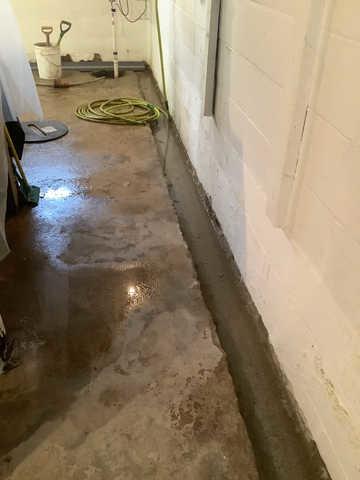
Stabilization and Waterproofing
In order to correct this bowing foundation wall, we installed six Fortress Carbon Fiber Straps on the south wall of the basement. We ground the wall surface to prepare for the initial epoxy layer. We then used hydraulic cement to patch a small area at the bottom that had sheared and attached neck ties to the rim joist and bridged all six straps. Around the perimeter of the basement, approximately 12 inches of concrete was broken away from the wall to install the WaterGuard system. Every hollow block core was drilled to add weep holes. Filter cloth and bed of stone was also installed for additional drainage. The floor was put back together and the system was tied into the existing sump pump.
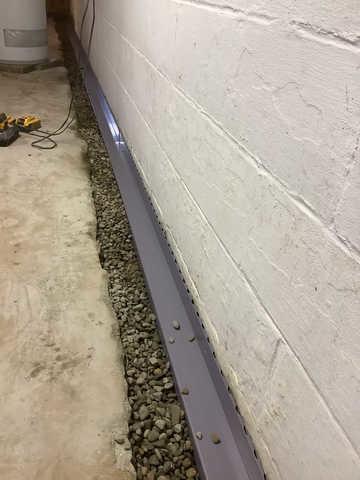
Stabilization and Waterproofing
In order to correct this bowing foundation wall, we installed six Fortress Carbon Fiber Straps on the south wall of the basement. We ground the wall surface to prepare for the initial epoxy layer. We then used hydraulic cement to patch a small area at the bottom that had sheared and attached neck ties to the rim joist and bridged all six straps. Around the perimeter of the basement, approximately 12 inches of concrete was broken away from the wall to install the WaterGuard system. Every hollow block core was drilled to add weep holes. Filter cloth and bed of stone was also installed for additional drainage. The floor was put back together and the system was tied into the existing sump pump.
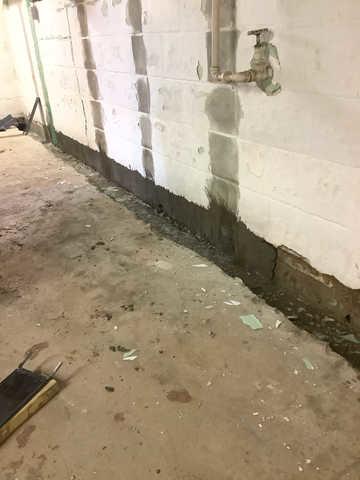
Stabilization and Waterproofing
In order to correct this bowing foundation wall, we installed six Fortress Carbon Fiber Straps on the south wall of the basement. We ground the wall surface to prepare for the initial epoxy layer. We then used hydraulic cement to patch a small area at the bottom that had sheared and attached neck ties to the rim joist and bridged all six straps. Around the perimeter of the basement, approximately 12 inches of concrete was broken away from the wall to install the WaterGuard system. Every hollow block core was drilled to add weep holes. Filter cloth and bed of stone was also installed for additional drainage. The floor was put back together and the system was tied into the existing sump pump.
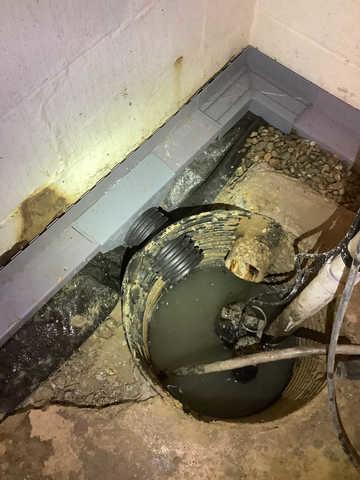
Stabilization and Waterproofing
In order to correct this bowing foundation wall, we installed six Fortress Carbon Fiber Straps on the south wall of the basement. We ground the wall surface to prepare for the initial epoxy layer. We then used hydraulic cement to patch a small area at the bottom that had sheared and attached neck ties to the rim joist and bridged all six straps. Around the perimeter of the basement, approximately 12 inches of concrete was broken away from the wall to install the WaterGuard system. Every hollow block core was drilled to add weep holes. Filter cloth and bed of stone was also installed for additional drainage. The floor was put back together and the system was tied into the existing sump pump.
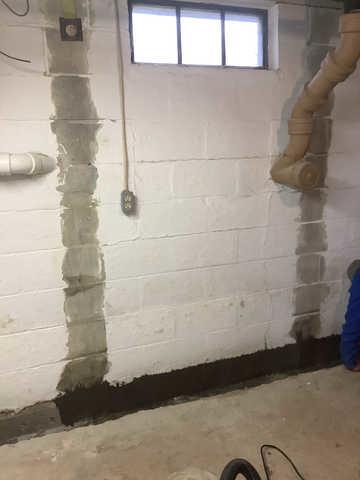
Stabilization and Waterproofing
In order to correct this bowing foundation wall, we installed six Fortress Carbon Fiber Straps on the south wall of the basement. We ground the wall surface to prepare for the initial epoxy layer. We then used hydraulic cement to patch a small area at the bottom that had sheared and attached neck ties to the rim joist and bridged all six straps. Around the perimeter of the basement, approximately 12 inches of concrete was broken away from the wall to install the WaterGuard system. Every hollow block core was drilled to add weep holes. Filter cloth and bed of stone was also installed for additional drainage. The floor was put back together and the system was tied into the existing sump pump.
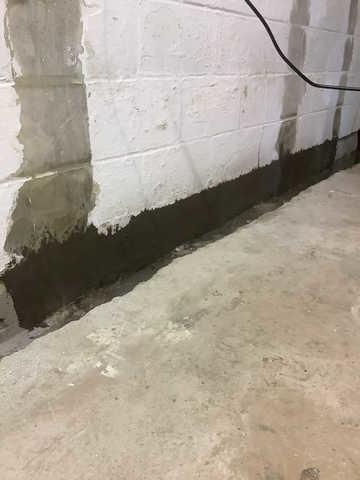
Stabilization and Waterproofing
In order to correct this bowing foundation wall, we installed six Fortress Carbon Fiber Straps on the south wall of the basement. We ground the wall surface to prepare for the initial epoxy layer. We then used hydraulic cement to patch a small area at the bottom that had sheared and attached neck ties to the rim joist and bridged all six straps. Around the perimeter of the basement, approximately 12 inches of concrete was broken away from the wall to install the WaterGuard system. Every hollow block core was drilled to add weep holes. Filter cloth and bed of stone was also installed for additional drainage. The floor was put back together and the system was tied into the existing sump pump.
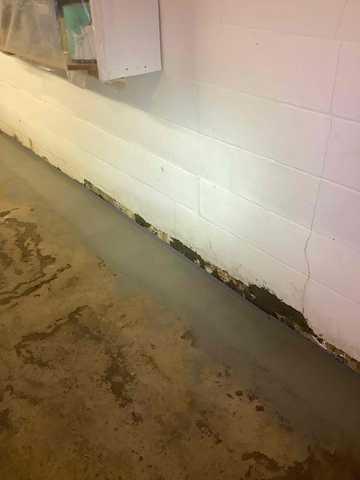
Stabilization and Waterproofing
In order to correct this bowing foundation wall, we installed six Fortress Carbon Fiber Straps on the south wall of the basement. We ground the wall surface to prepare for the initial epoxy layer. We then used hydraulic cement to patch a small area at the bottom that had sheared and attached neck ties to the rim joist and bridged all six straps. Around the perimeter of the basement, approximately 12 inches of concrete was broken away from the wall to install the WaterGuard system. Every hollow block core was drilled to add weep holes. Filter cloth and bed of stone was also installed for additional drainage. The floor was put back together and the system was tied into the existing sump pump.
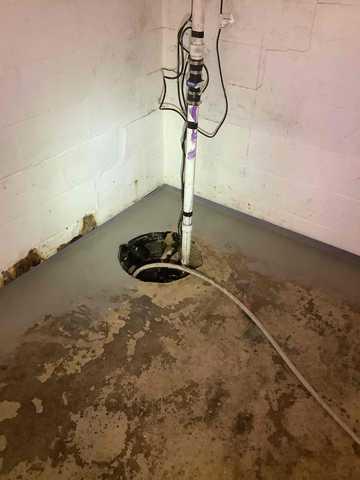
Stabilization and Waterproofing
In order to correct this bowing foundation wall, we installed six Fortress Carbon Fiber Straps on the south wall of the basement. We ground the wall surface to prepare for the initial epoxy layer. We then used hydraulic cement to patch a small area at the bottom that had sheared and attached neck ties to the rim joist and bridged all six straps. Around the perimeter of the basement, approximately 12 inches of concrete was broken away from the wall to install the WaterGuard system. Every hollow block core was drilled to add weep holes. Filter cloth and bed of stone was also installed for additional drainage. The floor was put back together and the system was tied into the existing sump pump.

Stabilization and Waterproofing
In order to correct this bowing foundation wall, we installed six Fortress Carbon Fiber Straps on the south wall of the basement. We ground the wall surface to prepare for the initial epoxy layer. We then used hydraulic cement to patch a small area at the bottom that had sheared and attached neck ties to the rim joist and bridged all six straps. Around the perimeter of the basement, approximately 12 inches of concrete was broken away from the wall to install the WaterGuard system. Every hollow block core was drilled to add weep holes. Filter cloth and bed of stone was also installed for additional drainage. The floor was put back together and the system was tied into the existing sump pump.
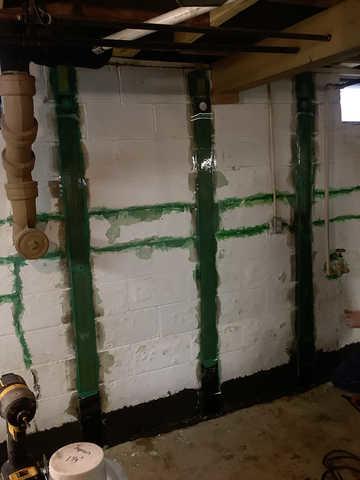
Stabilization and Waterproofing
In order to correct this bowing foundation wall, we installed six Fortress Carbon Fiber Straps on the south wall of the basement. We ground the wall surface to prepare for the initial epoxy layer. We then used hydraulic cement to patch a small area at the bottom that had sheared and attached neck ties to the rim joist and bridged all six straps. Around the perimeter of the basement, approximately 12 inches of concrete was broken away from the wall to install the WaterGuard system. Every hollow block core was drilled to add weep holes. Filter cloth and bed of stone was also installed for additional drainage. The floor was put back together and the system was tied into the existing sump pump.

Stabilization and Waterproofing
In order to correct this bowing foundation wall, we installed six Fortress Carbon Fiber Straps on the south wall of the basement. We ground the wall surface to prepare for the initial epoxy layer. We then used hydraulic cement to patch a small area at the bottom that had sheared and attached neck ties to the rim joist and bridged all six straps. Around the perimeter of the basement, approximately 12 inches of concrete was broken away from the wall to install the WaterGuard system. Every hollow block core was drilled to add weep holes. Filter cloth and bed of stone was also installed for additional drainage. The floor was put back together and the system was tied into the existing sump pump.
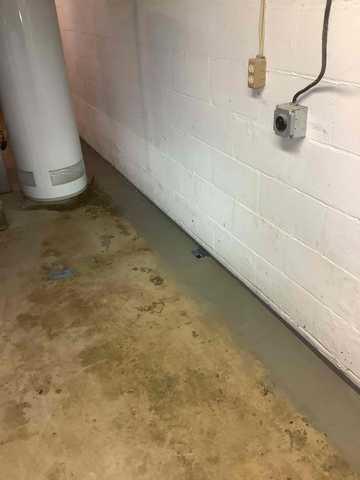
Stabilization and Waterproofing
In order to correct this bowing foundation wall, we installed six Fortress Carbon Fiber Straps on the south wall of the basement. We ground the wall surface to prepare for the initial epoxy layer. We then used hydraulic cement to patch a small area at the bottom that had sheared and attached neck ties to the rim joist and bridged all six straps. Around the perimeter of the basement, approximately 12 inches of concrete was broken away from the wall to install the WaterGuard system. Every hollow block core was drilled to add weep holes. Filter cloth and bed of stone was also installed for additional drainage. The floor was put back together and the system was tied into the existing sump pump.
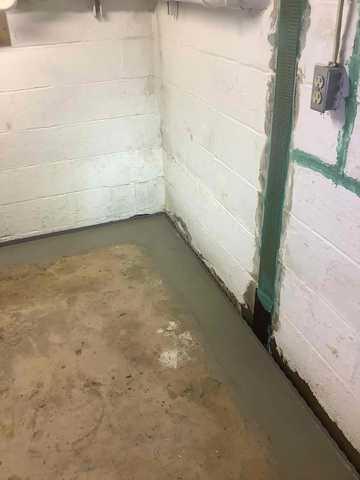
Stabilization and Waterproofing
In order to correct this bowing foundation wall, we installed six Fortress Carbon Fiber Straps on the south wall of the basement. We ground the wall surface to prepare for the initial epoxy layer. We then used hydraulic cement to patch a small area at the bottom that had sheared and attached neck ties to the rim joist and bridged all six straps. Around the perimeter of the basement, approximately 12 inches of concrete was broken away from the wall to install the WaterGuard system. Every hollow block core was drilled to add weep holes. Filter cloth and bed of stone was also installed for additional drainage. The floor was put back together and the system was tied into the existing sump pump.
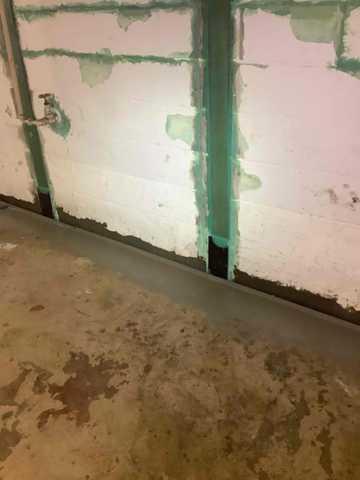
Stabilization and Waterproofing
In order to correct this bowing foundation wall, we installed six Fortress Carbon Fiber Straps on the south wall of the basement. We ground the wall surface to prepare for the initial epoxy layer. We then used hydraulic cement to patch a small area at the bottom that had sheared and attached neck ties to the rim joist and bridged all six straps. Around the perimeter of the basement, approximately 12 inches of concrete was broken away from the wall to install the WaterGuard system. Every hollow block core was drilled to add weep holes. Filter cloth and bed of stone was also installed for additional drainage. The floor was put back together and the system was tied into the existing sump pump.

Stabilization and Waterproofing
In order to correct this bowing foundation wall, we installed six Fortress Carbon Fiber Straps on the south wall of the basement. We ground the wall surface to prepare for the initial epoxy layer. We then used hydraulic cement to patch a small area at the bottom that had sheared and attached neck ties to the rim joist and bridged all six straps. Around the perimeter of the basement, approximately 12 inches of concrete was broken away from the wall to install the WaterGuard system. Every hollow block core was drilled to add weep holes. Filter cloth and bed of stone was also installed for additional drainage. The floor was put back together and the system was tied into the existing sump pump.
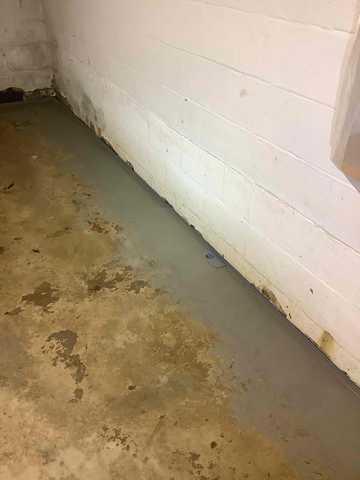
Stabilization and Waterproofing
In order to correct this bowing foundation wall, we installed six Fortress Carbon Fiber Straps on the south wall of the basement. We ground the wall surface to prepare for the initial epoxy layer. We then used hydraulic cement to patch a small area at the bottom that had sheared and attached neck ties to the rim joist and bridged all six straps. Around the perimeter of the basement, approximately 12 inches of concrete was broken away from the wall to install the WaterGuard system. Every hollow block core was drilled to add weep holes. Filter cloth and bed of stone was also installed for additional drainage. The floor was put back together and the system was tied into the existing sump pump.
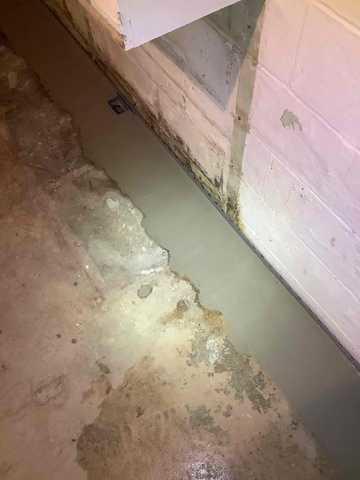
Stabilization and Waterproofing
In order to correct this bowing foundation wall, we installed six Fortress Carbon Fiber Straps on the south wall of the basement. We ground the wall surface to prepare for the initial epoxy layer. We then used hydraulic cement to patch a small area at the bottom that had sheared and attached neck ties to the rim joist and bridged all six straps. Around the perimeter of the basement, approximately 12 inches of concrete was broken away from the wall to install the WaterGuard system. Every hollow block core was drilled to add weep holes. Filter cloth and bed of stone was also installed for additional drainage. The floor was put back together and the system was tied into the existing sump pump.
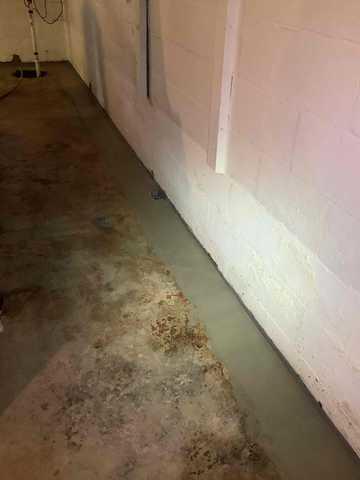
Stabilization and Waterproofing
In order to correct this bowing foundation wall, we installed six Fortress Carbon Fiber Straps on the south wall of the basement. We ground the wall surface to prepare for the initial epoxy layer. We then used hydraulic cement to patch a small area at the bottom that had sheared and attached neck ties to the rim joist and bridged all six straps. Around the perimeter of the basement, approximately 12 inches of concrete was broken away from the wall to install the WaterGuard system. Every hollow block core was drilled to add weep holes. Filter cloth and bed of stone was also installed for additional drainage. The floor was put back together and the system was tied into the existing sump pump.
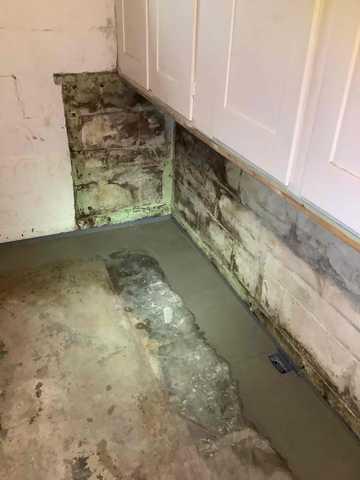
Stabilization and Waterproofing
In order to correct this bowing foundation wall, we installed six Fortress Carbon Fiber Straps on the south wall of the basement. We ground the wall surface to prepare for the initial epoxy layer. We then used hydraulic cement to patch a small area at the bottom that had sheared and attached neck ties to the rim joist and bridged all six straps. Around the perimeter of the basement, approximately 12 inches of concrete was broken away from the wall to install the WaterGuard system. Every hollow block core was drilled to add weep holes. Filter cloth and bed of stone was also installed for additional drainage. The floor was put back together and the system was tied into the existing sump pump.
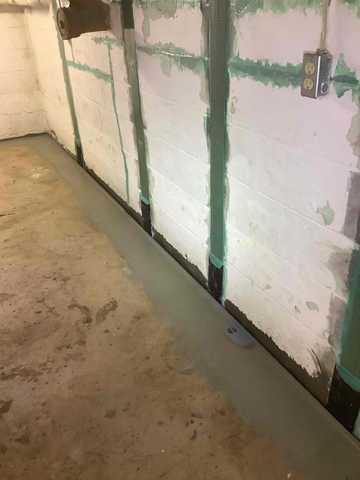
Stabilization and Waterproofing
In order to correct this bowing foundation wall, we installed six Fortress Carbon Fiber Straps on the south wall of the basement. We ground the wall surface to prepare for the initial epoxy layer. We then used hydraulic cement to patch a small area at the bottom that had sheared and attached neck ties to the rim joist and bridged all six straps. Around the perimeter of the basement, approximately 12 inches of concrete was broken away from the wall to install the WaterGuard system. Every hollow block core was drilled to add weep holes. Filter cloth and bed of stone was also installed for additional drainage. The floor was put back together and the system was tied into the existing sump pump.
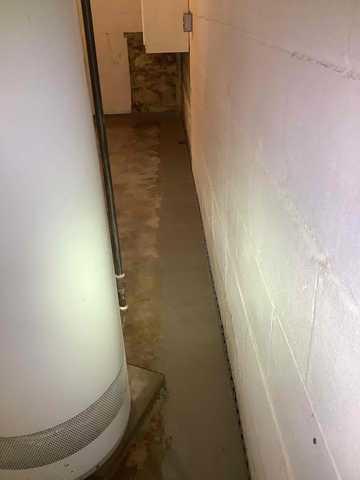
Stabilization and Waterproofing
In order to correct this bowing foundation wall, we installed six Fortress Carbon Fiber Straps on the south wall of the basement. We ground the wall surface to prepare for the initial epoxy layer. We then used hydraulic cement to patch a small area at the bottom that had sheared and attached neck ties to the rim joist and bridged all six straps. Around the perimeter of the basement, approximately 12 inches of concrete was broken away from the wall to install the WaterGuard system. Every hollow block core was drilled to add weep holes. Filter cloth and bed of stone was also installed for additional drainage. The floor was put back together and the system was tied into the existing sump pump.

Stabilization and Waterproofing
In order to correct this bowing foundation wall, we installed six Fortress Carbon Fiber Straps on the south wall of the basement. We ground the wall surface to prepare for the initial epoxy layer. We then used hydraulic cement to patch a small area at the bottom that had sheared and attached neck ties to the rim joist and bridged all six straps. Around the perimeter of the basement, approximately 12 inches of concrete was broken away from the wall to install the WaterGuard system. Every hollow block core was drilled to add weep holes. Filter cloth and bed of stone was also installed for additional drainage. The floor was put back together and the system was tied into the existing sump pump.
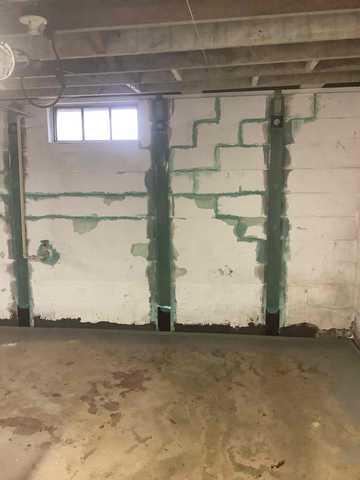
Stabilization and Waterproofing
In order to correct this bowing foundation wall, we installed six Fortress Carbon Fiber Straps on the south wall of the basement. We ground the wall surface to prepare for the initial epoxy layer. We then used hydraulic cement to patch a small area at the bottom that had sheared and attached neck ties to the rim joist and bridged all six straps. Around the perimeter of the basement, approximately 12 inches of concrete was broken away from the wall to install the WaterGuard system. Every hollow block core was drilled to add weep holes. Filter cloth and bed of stone was also installed for additional drainage. The floor was put back together and the system was tied into the existing sump pump.
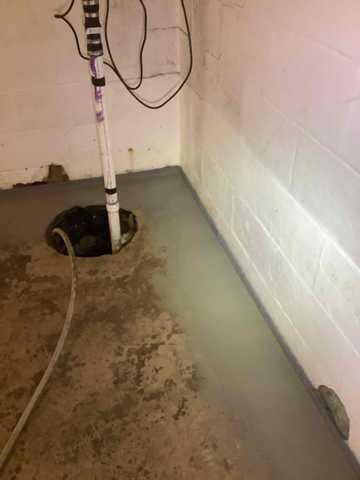
Stabilization and Waterproofing
In order to correct this bowing foundation wall, we installed six Fortress Carbon Fiber Straps on the south wall of the basement. We ground the wall surface to prepare for the initial epoxy layer. We then used hydraulic cement to patch a small area at the bottom that had sheared and attached neck ties to the rim joist and bridged all six straps. Around the perimeter of the basement, approximately 12 inches of concrete was broken away from the wall to install the WaterGuard system. Every hollow block core was drilled to add weep holes. Filter cloth and bed of stone was also installed for additional drainage. The floor was put back together and the system was tied into the existing sump pump.
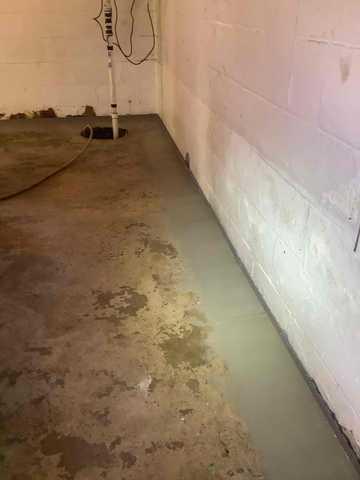
Stabilization and Waterproofing
In order to correct this bowing foundation wall, we installed six Fortress Carbon Fiber Straps on the south wall of the basement. We ground the wall surface to prepare for the initial epoxy layer. We then used hydraulic cement to patch a small area at the bottom that had sheared and attached neck ties to the rim joist and bridged all six straps. Around the perimeter of the basement, approximately 12 inches of concrete was broken away from the wall to install the WaterGuard system. Every hollow block core was drilled to add weep holes. Filter cloth and bed of stone was also installed for additional drainage. The floor was put back together and the system was tied into the existing sump pump.
